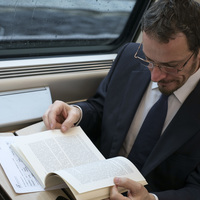Research Interests:
Research Interests:
Research Interests:
Research Interests:
Research Interests:
in La cultura dell’antico a Napoli nel Secolo dei Lumi. Omaggio a Fausto Zevi nel dì genetliaco, a cura di Carmela Capaldi e Massimo Osanna, Atti del Convegno Internazionale (Napoli-Ercolano 14-16 novembre 2018), «L’Erma» di... more
in La cultura dell’antico a Napoli nel Secolo dei Lumi. Omaggio a Fausto Zevi nel dì genetliaco, a cura di Carmela Capaldi e Massimo Osanna, Atti del Convegno Internazionale (Napoli-Ercolano 14-16 novembre 2018), «L’Erma» di Bretschneider, Roma 2020, pp. 307-318.
Research Interests:
Research Interests:
Research Interests:
Research Interests:
Research Interests:
Research Interests:
Since the official discovery of the Jewish catacombs of Venosa, Italy, in 1853, about 80 epitaphs and graffiti written in Hebrew, Greek and Latin have been found. These epitaphs constitute a unique source of information on the lives,... more
Since the official discovery of the Jewish catacombs of Venosa, Italy, in 1853, about 80 epitaphs and graffiti written in Hebrew, Greek and Latin have been found. These epitaphs constitute a unique source of information on the lives, family relationships and social status of the Jews living in late ancient Venusia. Although almost all of these inscriptions have long been accessible in published form, many doubts nonetheless persist as to their exact locations in the catacombs, and whether or not they remain in situ today. This article presents the results of a general survey undertaken in the catacombs in recent years, showing what has been lost and what actually remains.
Research Interests:
Research Interests:
Research Interests:
Research Interests:
Research Interests:
Research Interests:
Research Interests:
Research Interests:
In Michael Scott’s "Ars Alchemie" mention is made of a “magister Iacob” as an owner of a method useful for the tin dealbatio or bleaching. In this otherwise unknown figure, it has been often recognized the philosopher and physician... more
In Michael Scott’s "Ars Alchemie" mention is made of a “magister Iacob” as an owner of a method useful for the tin dealbatio or bleaching. In this otherwise unknown figure, it has been often recognized the philosopher and physician Ya‘aqov ben Abba Mari Anatoli (Marseille 1194 - Naples ? within 1247), who shared with Michael Scott some activity as a translator or mathematician at the court of emperor Frederick II. In this essay, it is discussed, among other things, the possible identification of the “magister Iacob” with a “Iacob alhartane iudeus” also known in sources of 12th-13th century. On the other hand, the reputation of Ya‘aqov Anatoli as an alchemist, which dates back at least to the 16th century, would be not without a reason, since in Anatoli’s main work, the Malmad ha-talmidim, there are frequently employed metaphors inspired by alchemistic procedures. At any rate, it is pointed out here, for the first time, that at the court of Frederick II there lived in Naples also another “magister Iacob”, a Jewish physician, maybe from Germany, whom existence is known from a document of 1243.
